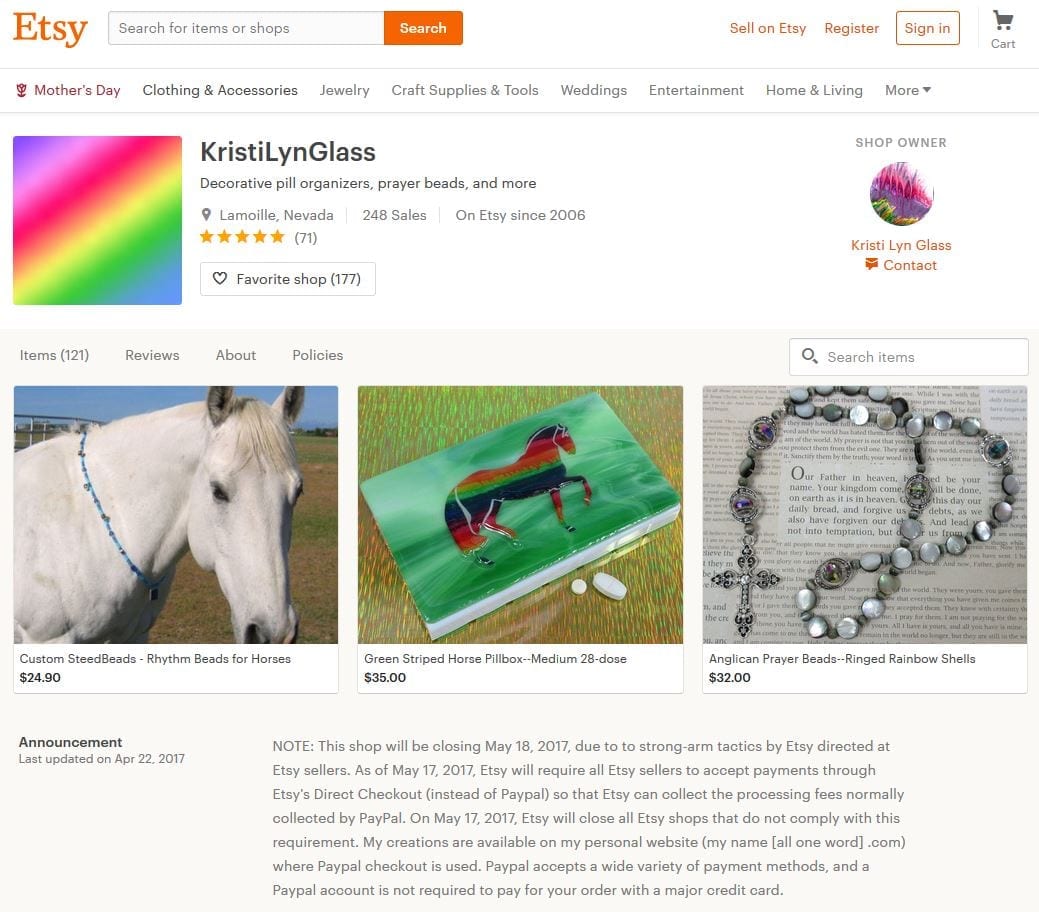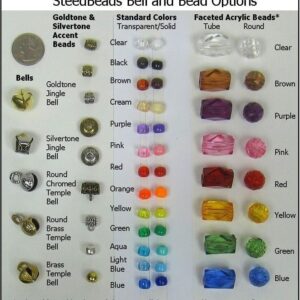
I joined Etsy.com as a seller in 2006, one year after its inception. After 11 years as a successful Etsy shop owner, I’ll be closing my Etsy shop on May 15, 2017, due to Etsy’s reprehensible strong-arm tactics directed at Etsy sellers. As of May 17, 2017, Etsy will require most Etsy shop owners (including all those in the USA) to accept payments through Etsy’s “Etsy Payments” interface instead of exclusively through Paypal, which many Etsy shop owners prefer, as I do. If a seller does not comply with this requirement, his or her Etsy shop(s) will be closed by Etsy on May 18, 2017.
All of my products, the vast majority of which have never been available in my Etsy shop, are available on my personal website KristiLynGlass.com. Therefore, I am in a far better situation than many other Etsy sellers who have been given less than a month’s notice to (1) comply, (2) scramble to find another way to market their products, or (3) go out of business. Those who have previously purchased my products via my Etsy shop are encouraged to bookmark my website and shop there for my products in the future.
Etsy’s Rationale and Requirements
Etsy is imposing this requirement to increase its revenue by collecting the payment processing fees that would otherwise be collected by Paypal. However, Etsy is not offering sellers the impeccable reliability, worldwide acceptance, pseudo banking services, and outstanding phone customer support that Paypal provides. Etsy only provides customer support via non-prompt (and sometimes ignored) email requests for a call. It also has a history of (on at least one occasion in 2016) fouling up its sellers’ finances so badly that customers had to wait a month to receive their orders and/or have their payments processed. Buyers are reporting serious problems with Etsy’s new shopping cart that allows purchases from multiple shops in the same cart. Sellers are currently reporting lengthy payment delays for product sales. Many sellers are therefore distrustful of Etsy’s ability to successfully manage their finances. Sellers are also unwilling to hand out personal information and bank account access to yet another entity.
Like Paypal, Etsy Payments accepts a wide variety of payment types, but using Etsy Payments will require Etsy sellers to:
- Provide Etsy with his or her social security number and a photo ID.
- Allow Etsy to access his or her bank account (for Etsy to both deposit and withdraw funds)
- Use Etsy’s shipping interface, which is limited and not as easy to use as Paypal’s
- Delay receipt of payments as long as 3 days, whereas Paypal allows instant access to received payments
If a seller chooses to continue to have payments made via PayPal to go into a Paypal account and other forms of payment to go into the seller’s bank account, the seller must set up and maintain accounting systems for both payment sources, adding to the seller’s workload. The layout of the Etsy buyer’s checkout screen visually funnels the buyer to check out via Etsy Payments, even though the Paypal payment option may be offered, thus maximizing the processing fees collected by Etsy and minimizing those received by Paypal.
Etsy’s Climate Change
Etsy’s founders built Etsy.com in 2005 on the premise that it would contain only handcrafted items made by its shop owners. Artists and crafters flocked to this venue to sell their wares in the Etsy marketplace. Over the years, the definition of “hand made” has definitely changed. Etsy is not curated. It allows the sale of mass produced items, encourages the sale of (Etsy approved) manufactured items as handmade, and doesn’t cull bad sellers. Some would call that a “flea market.”
Etsy began broadening its scope to allow sales of vintage items and art/craft supplies. The latter attracted large-scale sellers from China and other foreign countries who set up shops on Etsy containing thousands of items. Etsy collected fees for listing, selling, and renewing each of these items, allowing Etsy to grow exponentially. This led to Etsy initiating a public offering of its stock in March 2015. In the process, the original founders of Etsy sold out to a board of directors that has increasingly ignored Etsy’s initial premise and the needs and interests of the thousands of artists and crafters on whose backs Etsy was built.
This month, Etsy launched a spin-off site called Etsy Studio that has very close ties to Etsy.com. Etsy Studio offers how-to videos with detailed instructions and required tools/materials lists. Most of the required items on those lists link back to the products sold by suppliers via Etsy.
On May 2, 2017, a new shakeup in management occurred, and a new CEO is now in charge. Check out the first quarter 2017 financial report for details and insight into Etsy’s new direction.
You can see where Etsy is headed. It sees the art/craft supply market as a plum revenue source, rather than the artists and crafters who are offering handmade items for sale on Etsy. It is focused on making a profit, rather than its original ideals. Therefore, Etsy has no conscience about imposing requirements on artists/crafters that will effectively winnow out the smaller and perhaps less productive ones. This includes the mom and pop businesses who use Paypal as their business “bank account” and those who want to keep their accounting efforts to a minimum.
Impact on My Business
I currently pay a considerable amount of money to Google AdWords to advertise my products on the internet. When people conduct a Google internet search, text and display ads for my products will appear on the same page as related search results. Unfortunately, the majority of those ads have been driving customers to my Etsy shop, rather than to my personal website. I don’t know if Etsy and Google are in cahoots, but it certainly looks that way.
Once my Etsy shop has closed, I will be monitoring my AdWords account closely to determine its effectiveness in driving traffic to my personal website. I am hopeful that my website will receive more traffic, rather than less, but time will tell.
I hope and pray that my Etsy customers will find my products on my personal website, but I am sure that many of them will not make that effort. I will do what I can to alert them to my Etsy shop closing, but I anticipate that my sales revenue will experience a downturn in the near term as Etsy customers transition to finding my products elsewhere.
I invested heavily in the development of my personal website, so I consider this change an opportunity for the website to begin making more of a return on that investment.
Tallies
Below are Etsy’s current statistics on the number of items available in each category available from each location. The statistics change each minute, probably due to sales made and listings added/deleted. I calculated the “Elsewhere” stats by subtracting the USA stats from their respective Anywhere stats.
| 5/2/17 | All Items | Handmade | Vintage | Supplies |
| Anywhere | 45,275,971 | 33,507,366 | 7,944,436 | 7,847,570 |
| USA | 26,263,422 | 19,283,603 | 4,919,902 | 4,074,385 |
| Elsewhere | 19,013,252 | 14,223,763 | 3,024,534 | 3,773,185 |
Active Etsy sellers as of 12/31/16: 1,700,000
It will be interesting to compare these statistics to those available on 5/19/17, after Etsy closes the shops of noncompliant sellers.






















